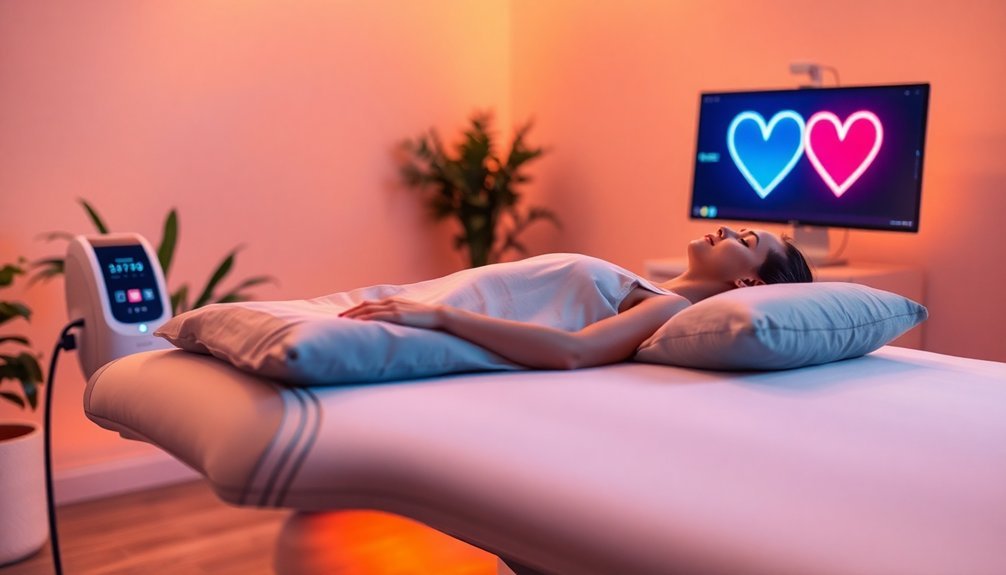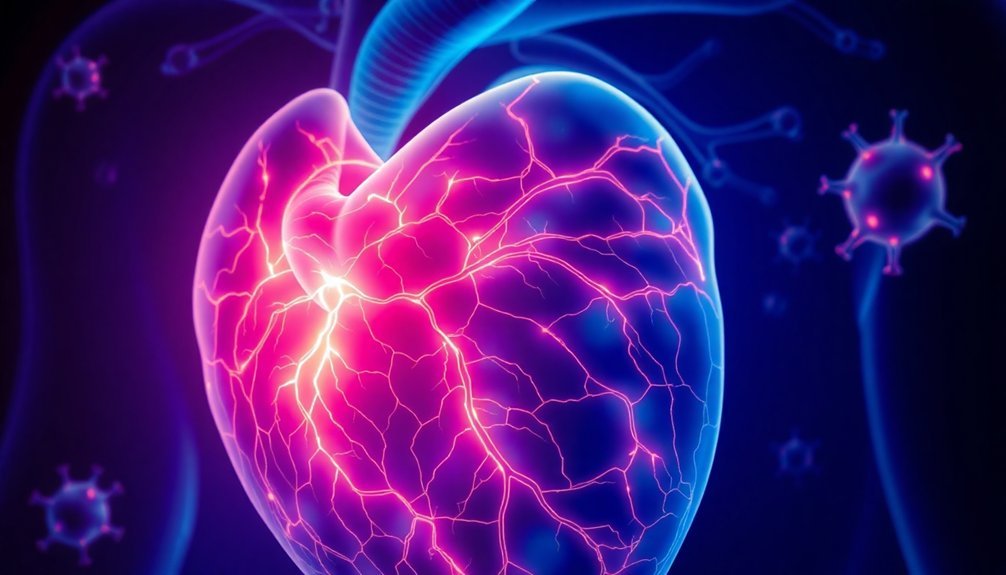Near-infrared therapy can greatly boost your heart health by promoting blood flow and reducing blood pressure. It works by increasing the efficiency of your heart, enhancing cellular energy, and stimulating blood vessel dilation. Over time, this therapy lowers your risk for heart-related diseases and can even help delay age-related heart deterioration. Regular sessions can considerably improve your overall heart function and longevity. It's essential, though, to consult with a healthcare professional before starting to make sure it's safe for you. If you're curious about how to get started and maximize benefits, there's more to explore.
Benefits of Near-Infrared Therapy

Near-infrared therapy offers a range of benefits that can greatly enhance your heart health and overall well-being. This innovative treatment effectively mitigates age-associated cardiovascular remodeling, reducing cardiac wall thickness and improving the heart's pumping action.
You'll experience an increase in your left ventricular ejection fraction, alongside a reduction in left atrial dimension and left ventricular end-diastolic volume, resulting in a more efficient heart function.
Moreover, this therapy promotes dilation of blood vessels, mirroring the effects of regular exercise. With blood flow increasing from 5-7 quarts per minute to as much as 13 quarts, your circulation will improve considerably, delivering oxygen to muscles and organs more efficiently. Regular use of infrared therapy can significantly enhance blood circulation, which contributes to overall heart health and vitality.
Enhanced circulation reduces the risk of heart-related diseases and contributes to lower blood pressure over time.
Regular sessions of near-infrared therapy can create lasting effects, keeping your blood pressure in check and reducing the volume of the inner lining of blood vessels.
Ultimately, you'll not only feel better but may also increase your longevity by delaying age-related heart deterioration. Embracing near-infrared therapy is a proactive step toward a healthier heart and a more vibrant life.
Mechanism of Photobiomodulation
You might be surprised to learn how photobiomodulation (PBM) works at the cellular level. By understanding how light parameters influence this process, you can appreciate the profound impacts near-infrared light has on cardiac tissue. LED-Red exposure, for instance, has been shown to significantly improve left ventricular function by reducing infarct size and enhancing cardiac repair mechanisms through targeted light application. Let's explore the mechanisms that drive these beneficial effects on heart health.
Photobiomodulation Explained
Photobiomodulation, a fascinating therapeutic approach, utilizes non-ionizing light to stimulate biological processes at the cellular level. When cells absorb this light, particularly through mitochondrial chromophores like cytochrome c oxidase, they initiate a cascade of beneficial reactions.
You'll see an increase in adenosine triphosphate (ATP) production, boosting cellular energy and enhancing metabolism. As light is absorbed, it also dissociates nitric oxide (NO) from cytochrome c oxidase. This restoration of normal cellular respiration aids in ATP production.
Additionally, this process modulates reactive oxygen species (ROS), impacting various physiological signaling pathways, including those that reduce inflammation and support healing. The therapy's effectiveness also hinges on the choice of optimal wavelengths and power, ensuring sufficient light penetration to target tissue.
You might be interested to know that increased mitochondrial membrane potential due to light absorption not only enhances ATP synthesis but also helps prevent cell death by sustaining normal cell functions.
The therapy promotes tissue regeneration by activating stem and progenitor cells while encouraging calcium signaling that influences gene expression.
Photobiomodulation reads like a powerful synthesis of energy and healing, amplifying the body's ability to restore health and efficiency at the cellular level.
Light Parameters Importance
Understanding the light parameters that impact photobiomodulation can greatly enhance heart health outcomes. By adjusting the wavelength, intensity, and duration of near-infrared (NIR) light exposure, you can maximize its benefits for your heart.
| Light Parameter | Importance |
|---|---|
| Wavelength (nm) | NIR between 810-1064 efficiently penetrates tissue. |
| Intensity (lumens) | Low doses (e.g., 10,000 lumens) boost gene activation. |
| Dose | Precise management is vital for safety and effect. |
| Duration | Short bursts (e.g., 2 min/day) can yield heart effects. |
| Frequency | Regular exposure is key; consistent treatments yield results. |
Effective NIR light exposure stimulates mitochondrial activity, enhancing ATP synthesis and improving metabolic functions. Additionally, regular exposure activates essential biological responses, like TGF-β1 and PER2 gene expression. These mechanisms not only protect your heart but also help delay cardiovascular aging. Adjusting these light parameters allows you to harness the full potential of photobiomodulation, paving the way for improved heart health.
Clinical Implications for Aging

As aging progresses, the heart often faces considerable challenges that can lead to various cardiovascular diseases; however, recent studies suggest that near-infrared light therapy may offer promising clinical implications for improving heart health.
Photobiomodulation (PBM) therapy has demonstrated its ability to enhance heart function in middle-aged mice by improving essential metrics like left ventricular (LV) ejection fraction and reducing aortic wall stiffness, which is critical for overall cardiovascular health.
Moreover, PBM can delay the onset of severe heart-related diseases, increasing survival rates dramatically, such as from 43% to 100% in genetically altered mice predisposed to heart disease. This therapy not only mitigates age-associated cardiovascular remodeling but also positively influences neuromuscular coordination, indicating benefits beyond cardiac function.
Regular exposure to PBM can remarkably enhance longevity and cumulative survival, making it an intriguing prospect for anti-aging strategies.
As the fields of photobiomodulation and cardiovascular research continue to evolve, future clinical trials in humans could further validate these findings, opening doors to innovative treatments tailor-made for aging populations seeking to maintain heart health and overall well-being.
Comparing Therapy Approaches
With the promising findings from near-infrared (NIR) light therapy regarding heart health, it's essential to compare this approach to other available therapies. NIR therapy improves vascular function by enhancing blood flow and supporting natural inflammation reduction, which can benefit your cardiovascular health.
It also reduces resting heart rate and may lower blood pressure, albeit with less detail in studies compared to far infrared (FIR) therapy.
While NIR light penetrates deeper into tissues, it provides surface-level heating and lacks as extensive research supporting direct heart health benefits as FIR. FIR therapy has been shown to enhance artery health and cardiac function, making it a more established alternative.
However, if you're looking to relieve muscle and joint pain, NIR therapy could be more effective, indirectly boosting your physical activity levels beneficial for heart health.
Combining both NIR and FIR in saunas can provide a holistic approach to well-being. Yet, it's important to recognize that NIR therapy requires more specific research to fully understand its cardiovascular benefits compared to FIR, which has substantial clinical support.
Safety and Administering Parameters

When considering near-infrared light therapy, you need to pay attention to ideal light wavelengths, typically in the 700-1100 nm range.
It's also essential to follow exposure duration guidelines to maximize benefits while minimizing risks.
Always prioritize safety precautions, especially if you have existing health conditions or are pregnant.
Optimal Light Wavelengths
Near-infrared (NIR) light plays an essential role in therapeutic applications, particularly for heart health.
When you're considering NIR, focus on wavelengths from approximately 700nm to 1,100nm, with 800-880 nm providing the most significant therapeutic benefits. Among these, 850nm is particularly effective for deep tissue and wound healing.
You can also enhance the effects of NIR by combining it with red light wavelengths like 630nm and 660nm.
This combination may improve cardiovascular health by boosting ATP production and reducing inflammation.
Additionally, yellow or amber light (580nm) can offer skin healing benefits, enriching your treatment approach.
Exposure Duration Guidelines
To harness the therapeutic benefits of near-infrared light for heart health, it's important to follow specific exposure duration guidelines. You should aim for exposure five days a week, starting with just a few minutes per day. Research indicates that even two minutes of daily exposure can yield benefits.
As you commit to this regimen, remember that consistency matters—long-term exposure over several weeks or months is vital for noticeable improvements.
Seasonal considerations also play a role; winter exposure often provides more consistent health benefits due to reduced natural sunlight. For effective results, you might need to extend your exposure time when it's colder—potentially up to 16 minutes in winter versus 12 minutes in summer.
Aim for a cumulative dose of 6.5 J·cm² over time for best health outcomes. Many initial studies show that lower doses usually produce less dependable results.
While you're adjusting your exposure duration, keep in mind that the intensity and ambient conditions can affect how quickly you reach that desired dose. By adhering to these guidelines, you'll maximize the heart health benefits of near-infrared light therapy.
Safety Precautions Required
Ensuring safety is essential when utilizing near-infrared light therapy for heart health. Before starting any treatment, consult your healthcare professional, especially if you have pre-existing heart conditions like coronary artery disease or uncontrolled hypertension.
Discussing your medical history is vital to identify any risks associated with your health.
Be cautious if you have conditions such as orthostatic hypotension or heart valve disease. Dehydration and overheating pose additional risks, so keep an eye on your hydration levels. Always stay well-hydrated before, during, and after your sessions.
Avoid using the sauna if you're feeling light-headed or overheated.
Ensure that the infrared sauna you're using is well-maintained and follows industry cleaning protocols. Use protective eyewear to shield your eyes from infrared radiation, and maintain a safe distance from the source to prevent burns.
Monitor your body's signals, and if you experience discomfort, stop the session.
Avoid alcohol before and after your sauna use to prevent complications. Additionally, steer clear of sudden temperature changes post-session.
Future Research Opportunities
Future research opportunities in near-infrared technologies for heart health are abundant and promising. You can expect exciting developments as studies explore intracoronary NIRS-IVUS to identify vulnerable atherosclerotic plaques, improving stenting procedures and reducing myonecrosis risks.
Also, research is underway to optimize carotid artery stenting and minimize the risk of periprocedural stroke. Clinical trials investigating therapies like far infrared sauna therapy could reveal beneficial effects on blood pressure and heart failure management.
Techniques like waon therapy need more exploration to assess their potential in reducing hospitalizations for chronic heart failure patients. Additionally, you're bound to see studies validating the effects of photobiomodulation therapy in slowing cardiovascular aging.
Technological advancements promise improvements in NIRS-IVUS systems for better accuracy and integration with imaging techniques like OCT. You might also witness the development of portable devices, expanding access to these technologies.
Finally, translating these advancements into public health initiatives could greatly raise awareness and incorporate successful strategies into standard cardiac care. These multidimensional opportunities uniquely position near-infrared technology to enhance heart health outcomes in the future.
Summary of Key Findings

The promising future of near-infrared technologies for heart health is supported by considerable findings that highlight their cardiovascular benefits. For instance, regular infrared sauna use can lower your risk for fatal heart disease by 50%, sudden cardiac death by 60%, and stroke by 51%.
Additionally, you'll experience lowered blood pressure—with improvements in systolic and diastolic measurements—temporarily and with ongoing use.
Waon therapy, which uses far infrared saunas, enhances cardiac function and exercise capacity, and can decrease hospitalization and death rates by 50% in people with severe heart issues over five years.
The therapy is simple: spend 15 minutes in a sauna at 60°C (140°F), followed by 30 minutes wrapped in a warm blanket, which raises your body temperature by 1°C (2°F).
Moreover, sessions mimic moderate-intensity exercise, increasing your heart rate considerably and improving vascular function.
Clinical studies have documented these benefits, showing reduced blood pressure, improved cardiac function, and enhanced quality of life for patients with chronic heart failure.
Frequently Asked Questions
Is Near-Infrared Light Therapy Suitable for Everyone?
Near-infrared light therapy isn't suitable for everyone. If you have certain medical conditions, like cancer or cardiovascular issues, consult your doctor first. It's essential to guarantee it's safe for your specific health situation.
How Often Should Near-Infrared Light Therapy Be Administered?
You should administer near-infrared light therapy consistently, aiming for low doses like 2 minutes daily, five days a week. Gradually adjust the duration and intensity based on your body's response and any observed effects.
What Are the Costs Associated With Near-Infrared Light Therapy?
When considering near-infrared light therapy, you'll encounter various costs, ranging from device prices to session fees. Your overall expense depends on treatment frequency, device customization, and whether you choose home or professional administration.
Can Near-Infrared Light Therapy Replace Traditional Heart Treatments?
You can't replace traditional heart treatments with near-infrared light therapy just yet. While it's promising, more research is needed to confirm its effectiveness and determine how it may complement existing therapies for heart conditions.
Are There Any Side Effects From Near-Infrared Light Therapy?
Yes, you might experience side effects from near-infrared light therapy, such as headaches, eye strain, and skin irritation. It's important to wear protective goggles and consult a healthcare provider to manage any potential risks effectively.
In Summary
To conclude, near-infrared therapy holds great promise for heart health by enhancing circulation, reducing inflammation, and promoting healing. By understanding the mechanisms behind photobiomodulation, you can better appreciate its potential benefits, especially as we age. As research continues to explore various therapy approaches and safety parameters, you might find that near-infrared therapy could be a valuable addition to your health regimen. Stay informed about future studies to discover how it can further improve cardiovascular well-being.





Leave a Reply